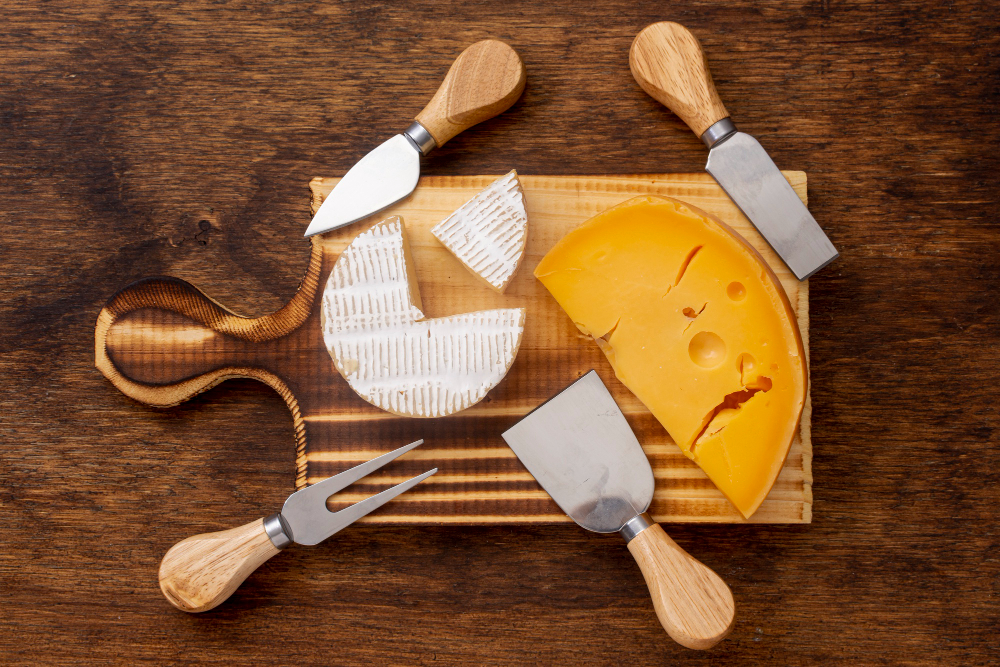At moments of gathering with fine wine and smooth cheese, a professional cheese knife acts almost like a connoisseur sommelier, able to perfectly present the cheese’s texture and flavor. In Western culture, the cheese knife is not just a daily tool, but also a part of the artistry of the dining experience. This article will take you into the world of cheese knives, exploring the science and aesthetics behind their sophisticated designs, to enhance your cheese enjoyment experience.

The Design Philosophy of Cheese Knives
The cheese knife is a perfect blend of craft and functionality. The design of each cheese knife takes into account the texture and cutting method appropriate for different types of cheese. Knives for cutting hard cheese are typically made sturdier to exert more force, while knives for soft cheese often have broader surfaces and holes to help reduce sticking. Understanding these thoughtful design elements not only helps you better select and use cheese knives but also allows you to exhibit professionalism while savoring cheese.
Different Types of Cheese Knives and Their Uses
Spreader: The Perfect Companion for Soft Cheese
When savoring soft cheeses such as Brie or Mascarpone, a Spreader is an essential tool. This type of cheese knife typically has a rounded tip and a broad blade, a design that allows for spreading without damaging the structure of the cheese or exerting too much force which could cause the cheese to crumble. The Spreader is the ideal choice for creating cheese platters or preparing spreadable appetizers, allowing for easy application on bread or crackers, delivering a perfect start to your taste experience.
Fork-Tipped Spear: The Ideal Choice for Hard Cheese
For aficionados of hard cheeses, the Fork-Tipped Spear is an excellent selection. This cheese knife usually features a slender blade with a forked tip, intended for handling hard cheeses like Parmesan or aged cheddar. The forked tip not only allows for easy penetration into the hard cheese, making cutting more effortless, but it can also be used to conveniently pick up and serve the cut pieces of cheese. At cheese tasting events, the Fork-Tipped Spear is a mark of professionalism.
Chisel Knife: The Sculptor of Aged, Hard Cheese
The Chisel Knife is commonly used to handle very hard and aged cheeses, such as Grana Padano or Pecorino. Its broad blade allows the user to distribute force evenly over a larger area while applying pressure, enabling one to “chisel” off pieces of cheese. It is the ideal tool for hard cheese enthusiasts, allowing users to cut their favorite cheese in a very controlled and precise manner.

Bell Knife: The Perfect Companion for Semi-Soft Cheese
The Bell Knife, also known as the Parmesan Knife, is specifically designed for cutting semi-soft to hard cheeses. Inspired by its bell-shaped appearance, the round head of this cheese knife is suitable for shaving and cutting round-shaped cheeses like Gouda or Edam. Additionally, the Bell Knife is also great for scooping out the “heart” of the cheese—a delightful experience sought after by many cheese connoisseurs.
Clever Use of the Cheese Wire
Beyond traditional cheese knives, the Cheese Wire is a marvelous tool. This seemingly simple device, typically consisting of a metal wire with two fixed handles, is particularly suitable for cutting uniform slices of cheese. Because it reduces the downward pressure during cutting, the cheese wire can easily cut soft to semi-hard cheeses, such as mozzarella or cheddar. It not only maintains the integrity and aesthetic of the cheese but also makes it much easier to handle when preparing sandwiches or cheese platters.

Multifunctionality of the Cheese Grater
The Cheese Grater is an indispensable multifunctional tool in the kitchen, especially when a large amount of shredded cheese is needed, such as in making pizza or pasta dishes. Unlike knives, a cheese grater can quickly shred hard or semi-hard cheeses into fine bits, making them ready for consumption and cooking. Modern cheese graters typically include surfaces of various coarseness, allowing you to produce cheese shreds of different sizes as needed. Notably, some cheese graters even come with a container to collect the cheese as it’s grated, reducing the cleaning burden in the kitchen. Cleaning: Since the grating surface of a cheese grater can be sharp, it is recommended to clean it with a brush under running water to prevent hand injuries and ensure all cheese remnants are removed.
Material Selection for Cheese Knives
Different materials have different effects on the cheese cutting experience. Choosing a cheese knife with the appropriate material is crucial for enhancing the cheese-cutting experience. The material of the cheese knife directly affects the durability, antibacterial properties, and the feel during use.
Cutting Techniques and Maintenance Tips
Maintaining Sharpness: A sharp cheese knife can cut cheese more precisely, preserving its shape and texture. Cleaning: After use, cheese knives should be immediately washed with warm water and a mild detergent to maintain hygiene and prolong their lifespan. Storage: Cheese knives should be stored in a dry place and kept away from hard surfaces to avoid damage to the blade. Conclusion: A cheese knife is the link between fine food and the art of living. Understanding and using the right cheese knife not only enhances your dining experience but also showcases your taste and expertise in social settings. Each knife has its unique purpose, adding joy to the consumption of cheese and highlighting your understanding and respect for culinary culture in social gatherings. The next time you prepare a cheese board, consider displaying your professional skills and share the exquisite pleasure from the world of cheese with friends and family.
